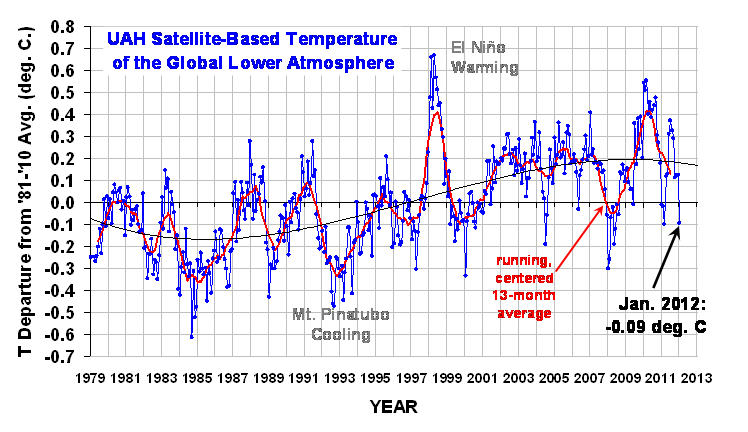PERSONAL NOTE: I’ve been unavailable for a while…my oldest daughter was in a bad car accident, will be OK eventually, but won’t walk for about 3 months. So, I might not be answering queries.
The global average lower tropospheric temperature anomaly for January, 2012 took a precipitous plunge, not totally unexpected for a La Nina January (click on the image for the full-size version):

The 3rd order polynomial fit to the data (courtesy of Excel) is for entertainment purposes only, and should not be construed as having any predictive value whatsoever.
Here are the monthly stats:
YR MON GLOBAL NH SH TROPICS
2011 1 -0.010 -0.055 +0.036 -0.372
2011 2 -0.020 -0.042 +0.002 -0.348
2011 3 -0.101 -0.073 -0.128 -0.342
2011 4 +0.117 +0.195 +0.039 -0.229
2011 5 +0.133 +0.145 +0.121 -0.043
2011 6 +0.315 +0.379 +0.250 +0.233
2011 7 +0.374 +0.344 +0.404 +0.204
2011 8 +0.327 +0.321 +0.332 +0.155
2011 9 +0.289 +0.304 +0.274 +0.178
2011 10 +0.116 +0.169 +0.062 -0.054
2011 11 +0.123 +0.075 +0.170 +0.024
2011 12 +0.126 +0.197 +0.055 +0.041
2012 01 -0.093 -0.059 -0.127 -0.138
Progress continues on Version 6 of our global temperature dataset. You can anticipate a little cooler anomalies than recently reported, maybe by a few hundredths of a degree, due to a small warming drift we have identified in one of the satellites carrying the AMSU instruments.

 Home/Blog
Home/Blog



